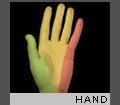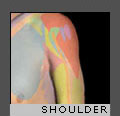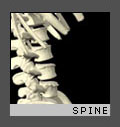Several factors have been identified as risk factors for elbow injuries in golf:
- Advancing age
- Faulty swing mechanics
- Lack of conditioning
- Insufficient warm-up
- Excessive practice or play
The vast majority of golf-related elbow injuries (for both amateur and pro) are tendon injuries (tendonitis). The most common form of golf-related elbow tendonitis occurs on the outer part of the left (lead) elbow and is referred to as tennis elbow. Less frequently, tendonitis injuries can occur to the inner portion of the right elbow (a condition called golferís elbow).
The elbow is susceptible to tendonitis injuries (tennis elbow and golferís elbow) at the transition from backswing to downswing (left image). Vigorous muscle contraction and tendon stretching from excessive wrist motion can lead to elbow tendonitis. At impact (right image), the forearm/elbow tendons are also under added stress as they absorb the force of the impact with the ball. An even greater jolt is absorbed by the elbows if the club strikes the ground or an object.
References:
Stanish W, Loebenberg M, Kozey J: The Elbow. In Stover CN, McCarroll JR, Mallon WJ (eds.): Feeling Up to Par: Medicine from Tee to Green. Philadelphia: F.A. Davis, 1994.
Kohn H: Prevention and Treatment of Elbow Injuries in Golf. Clinics in Sports Medicine 15(1): 65-83, 1996.






